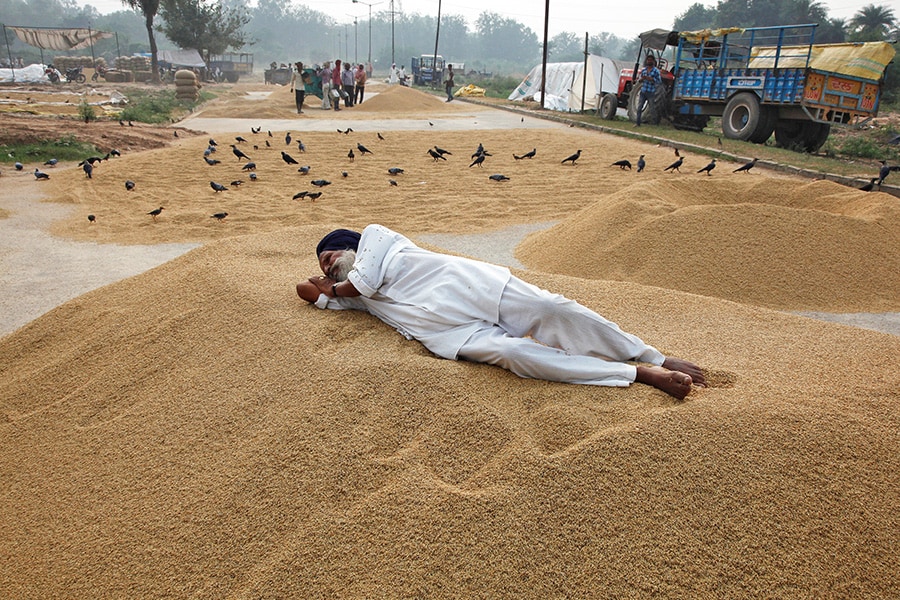
Farmers' protests: MSP and beyond
We need to recognise that the ongoing farmers' protests are a manifestation of a persistent agrarian crisis that has not received adequate attention for a long time
 There is empirical evidence to show that a well-functioning procurement system has positively affected returns to farmers.
Image: Ajay Verma / Reuters
There is empirical evidence to show that a well-functioning procurement system has positively affected returns to farmers.
Image: Ajay Verma / Reuters
Farmers' protests have again hit the national headlines. The past few days have seen farmer protests, even marked by a few unfortunate incidents. A primary demand of the protesting farmers is a legal guarantee of Minimum Support Price (MSP) for their crops.
MSP is the price at which public procurement happens. The public procurement operations as they exist today commenced in the Green Revolution era with two main objectives: ensuring food security and extending farmers' price support. The price support was a policy instrument encouraging farmers to adopt modern production technologies. MSP was expected to serve as a floor price for the surplus generated. Public procurement is limited to a few crops and a few regions. The quantity procured is also limited. Though MSP is announced every year for 23 crops (including sugarcane), its implementation is effective for only a few crops. The crops most actively procured are rice, wheat and, to some extent, pulses and cotton. Regional distribution of procurement by public agencies is highly skewed. In 2019-20, around 80 percent of the rice procured was from seven states, whereas almost all wheat procurement was from just five states. Public procurement is central to organising agricultural markets in Punjab and Haryana, to the extent that any diversification in cropping patterns is discouraged. At the same time, the procurement system is nearly absent in the eastern states.
Furthermore, the largest procurement operations are not necessarily in states that are the largest producers of rice and wheat. West Bengal and Uttar Pradesh, the largest producers of rice and wheat, respectively, in 2019-20, accounted for less than 12 percent of the total public procurement of these two crops. In several states, there is a wide gap between the quantity produced and the quantity procured by public agencies. Estimates suggest that only a minority of farmers benefit from public procurement operations and MSP.
Despite these limitations, there is empirical evidence to show that a well-functioning procurement system has positively affected returns to farmers. In districts where procurement operations are effective, the average market price of paddy is found to be higher than MSP by at least 4 percent. It provides a feasible option for farmers to dispose of their produce. Farmers are worse off in districts where they do not have access to public procurement. In the absence of public procurement, the bargaining power of farmers is likely to be weakened. In recent years, there has been an expansion of procurement activities in terms of both geographies and quantity. Actual procurement exceeded targeted quantities in several states. A few states have recorded significant improvements in public procurement. For instance, wheat procurement in Madhya Pradesh has drastically increased since 2007-08. Some scholars argue that smallholders have been the major beneficiaries of the expanded procurement operations. Yet, they acknowledge large farmer bias at the national level.
Is MSP the solution? MSP may be somewhat effective for the crops included in the PDS basket. In such cases, the government agencies need not depend on their trading effectiveness. Yet procurement from all regions of production may not be guaranteed. There is a strong argument for making MSP and public procurement broad-based. Though there is merit in this argument, the appropriateness of having MSP as the instrument for addressing agrarian distress is questionable. Merely announcing MSP is not enough. It needs to be followed up with effective procurement operations. The absence of this can create a widening gulf between expectations and actual realisations by farmers. Higher MSP may lead to supply response and a larger surplus for at least a few crops. If the procurement is not augmented proportionally, there could be significant price falls owing to inelastic demand. To pre-empt such undesirable circumstances, the government must respond with greater procurement quantities, obviously an added burden on the exchequer. In addition, the amounts procured will result in accumulated stock, which will eventually have to be disposed of through the market channels. Poor storage infrastructure, below-par trading capabilities of state agencies, and the inability to dispose of the surplus stock on time may result in huge losses. Thus, whether procurement is done at MSP or not, it can lead to a lose-lose outcome in the long run. At best, what MSP can offer is temporary relief with limited reach in terms of crops, geographies, and size class of farmers.
[This article has been published with permission from IIM Bangalore. www.iimb.ac.in Views expressed are personal.]







